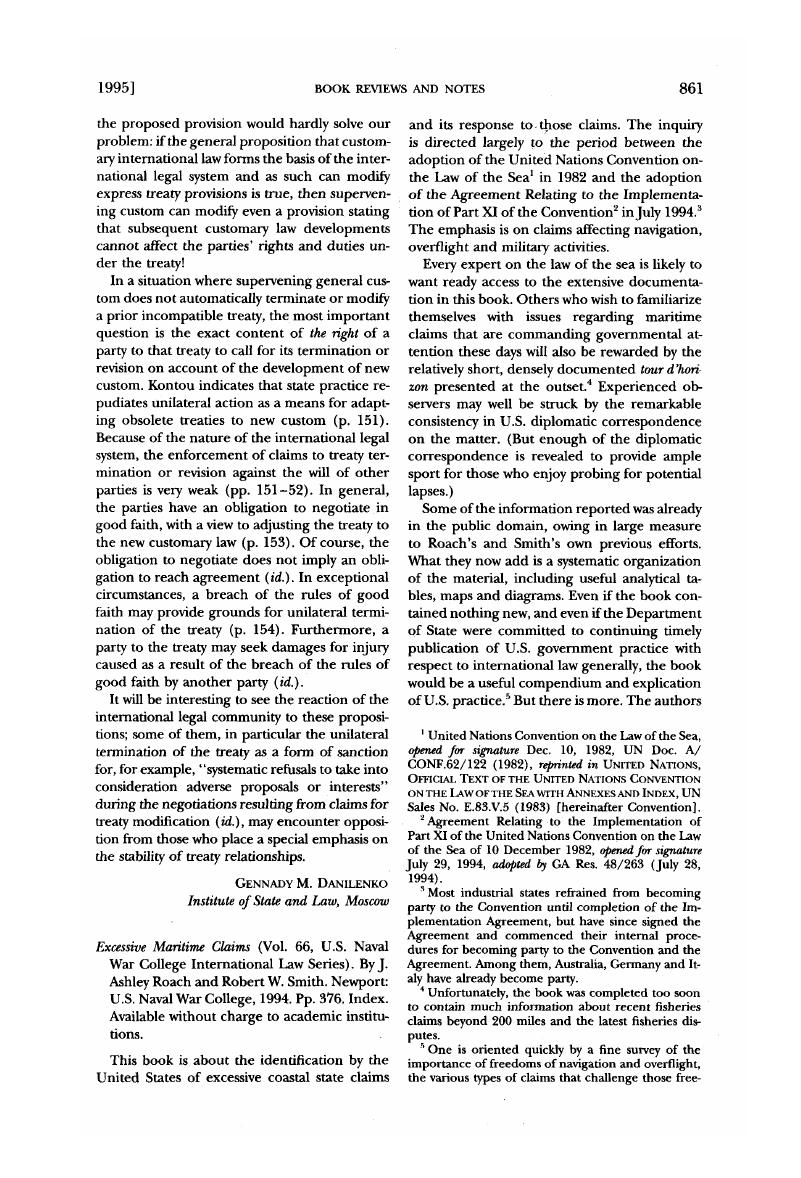No CrossRef data available.
Article contents
Excessive Maritime Claims (Vol. 66, U.S. Naval War College International Law Series). By J. Ashley Roach and Robert W. Smith. Newport: U.S. Naval War College, 1994. Pp. 376. Index. Available without charge to academic institutions.
Published online by Cambridge University Press: 27 February 2017
Abstract

- Type
- Book Reviews and Notes
- Information
- Copyright
- Copyright © American Society of International Law 1996
References
1 United Nations Convention on the Law of the Sea, opened for signature Dec. 10, 1982, UN Doc. A/ CONF.62/122 (1982), reprinted in UNITED NATIONS, OFFICIAL TEXT OF THE UNITED NATIONS CONVENTION ON THE LAW OF THE SEA WITH ANNEXES AND INDEX, UN Sales No. E.83.V.5 (1983) [hereinafter Convention].
2 Agreement Relating to the Implementation of Part XI of the United Nations Convention on the Law of the Sea of 10 December 1982, opened for signature July 29, 1994, adopted by GA Res. 48/263 (July 28, 1994).
3 Most industrial states refrained from becoming parry to the Convention until completion of the Implementation Agreement, but have since signed the Agreement and commenced their internal procedures for becoming party to the Convention and the Agreement. Among diem, Australia, Germany and Italy have already become party.
4 Unfortunately, the book was completed too soon to contain much information about recent fisheries claims beyond 200 miles and the latest fisheries disputes.
5 One is oriented quickly by a fine survey of the importance of freedoms of navigation and overflight, the various types of claims that challenge diose free-doms, and some examples of responses to such claims. The authors then divide their analysis between coastal state claims that are excessive for geographic reasons (claims that facially extend too far seaward) and those that are excessive for functional reasons (restrictions imposed on foreign activities that exceed coastal state competence in the relevant zone). In both contexts, they separately analyze claims, and responses to claims, regarding internal waters (including historic bays as well as waters enclosed by straight baselines), archipelagic waters, territorial seas, international straits, contiguous zones, exclusive economic zones and continental shelves.
6 Those with an allergy to “domino” theories might check the empirical data regarding coastal state claims since World War II—the accelerating emulation is undeniable.
7 The Special Working Committee on Maritime Claims of The American Society of International Law regarded the problem as serious enough to warn: “Those responsible for relations with particular coastal states should recognize that, so long as a program of exercise of rights is deemed necessary to protect underlying legal positions, delay for the sake of immediate political concerns may invite a deeper dispute at a later time.” ASIL NEWSLETTER, Mar.–May 1988, at 1.
8 This flag state obligation might arise as a specific application of the duty to have “due regard to the rights and duties of the coastal State” in the exclusive economic zone, as well as the duty to protect and preserve the marine environment. Convention, Arts. 58, 192 et seq. The Convention contains a qualified exemption for warships from the second, but not the first, duty. Id., Art. 236.
9 See discussion of the Flower Garden Banks marine sanctuary, Bernard H. Oxman & Anatoly L. Kolodkin, Stability in the Law of the Sea, in BEYOND CONFRONTATION: INTERNATIONAL LAW FOR THE POST-COLD WAR ERA 165, 189 n.59 (Lori F. Damrosch, Gennady M. Danilenko & Rein Müllerson eds., 1995).
10 Statement by the President, Mar. 10, 1983, 19 WEEKLY COMP. PRES. DOC. 383 (Mar. 14, 1983), reprinted in 22 ILM 464 (1983).




